Pad Woon Sen is a delightful Thai noodle dish prepared with glass noodles, crisp vegetables, and a savory-sweet sauce. The translation of “Pad Woon Sen” literally means “stir-fried glass noodles,” capturing its essence. Glass noodles, also called mung bean noodles, cellophane noodles, or thread noodles, are crafted from mung bean or green pea flour. These noodles have a translucent appearance and offer a smooth, chewy texture.
The distinctive Pad Woon Sen sauce is made from soy sauce, fish sauce, oyster sauce, sugar, and garlic. The most common vegetables used include bamboo shoots, peas, scallions, and carrots.
This dish is a perfect fit for a Weight Watchers program due to its health-conscious nature. Low in fats and calories, Pad Woon Sen presents itself as a wholesome and nutritious choice.

Why you should try this recipe
Pad Woon Sen offers a fantastic option for those on the journey to healthier eating, especially if you’re looking to diversify your noodle choices beyond traditional wheat-based options.
Pad Woon Sen features glass noodles, which are not made from wheat but rather mung bean or green pea flour. These noodles provide a satisfying and chewy texture while being gluten-free. They’re a wonderful alternative for anyone seeking a lighter and healthier way to enjoy noodles. Plus, they harmonize perfectly with the Weight Watchers approach, allowing you to indulge in a dish that’s both delicious and mindful of your well-being.
To further tailor this recipe to the Weight Watchers program, we’ll make a smart substitution by replacing the brown sugar with stevia, using just a small amount for that touch of sweetness and a guilt-free eating experience.
Servings: 4
Preparation time: 10 minutes
Cooking time: 10-15 minutes
Ingredients

· 100 g glass noodles
· 4 cups of water for soaking the noodles, 1 l.
· 1 tomato, 100 g.
· 1 white onion, 100 g.
· 1 cup finely chopped white cabbage, 150 g.
· 1 red bell pepper, 150 g.
· 1 carrot, 120 g.
· 2 eggs
· 2 stalks of green onion
· 1 teaspoon sesame oil
· 300 g boneless, skinless chicken breast
· 3 tablespoons reduced-sodium soy sauce
· 2 tablespoons oyster sauce
· 1 clove garlic, minced
· 1 teaspoon stevia
· 1 small piece of grated ginger (optional)
· Salt and pepper
Instructions for making Pad Woon Sen
1. Start by slicing the vegetables into extremely thin matchsticks. This includes the white onion, green onion, carrot, red bell pepper, and white cabbage. For the tomato, slice it into thin wedges that aren’t excessively thin.
2. Cut the chicken breast into bite-sized cubes. Season them with minced garlic, a pinch of salt, and a sprinkle of black pepper. Set the seasoned chicken aside.
3. Place the glass noodles in a bowl and cover them with 4 cups of water. You can either soak them all at once or soak them in batches, ensuring you have control over the amount of water they absorb.
4. Heat a teaspoon of sesame oil in a large pot or wok over medium-high heat. Add the seasoned chicken cubes and sauté for about 6 minutes, flipping them at the halfway mark. While the chicken cooks, prepare the sauce. In a small bowl, mix the reduced-sodium soy sauce, oyster sauce, stevia, grated ginger (if using), and a quarter cup of water. Stir well and set the sauce aside.
5. Once the chicken is cooked through, add all the prepared vegetables – white onion, green onion, carrot, red bell pepper, and white cabbage – to the pot. Stir-fry them until they begin to soften, maintaining their vibrant colors.
6. Carefully drain the soaked glass noodles and gently separate them. Add the noodles to the pot along with the sauce. Toss everything together to ensure the flavors are well distributed and the noodles are coated with the sauce.
7. In a separate skillet, beat the two eggs to create a thin omelet. Once cooked, slice the omelet into small pieces.
8. Just before serving, place the sliced egg omelet on top of the Pad Woon Sen. Serve Immediately: Dish out the Pad Woon Sen into individual serving bowls. Serve immediately to enjoy the flavors and textures at their best.
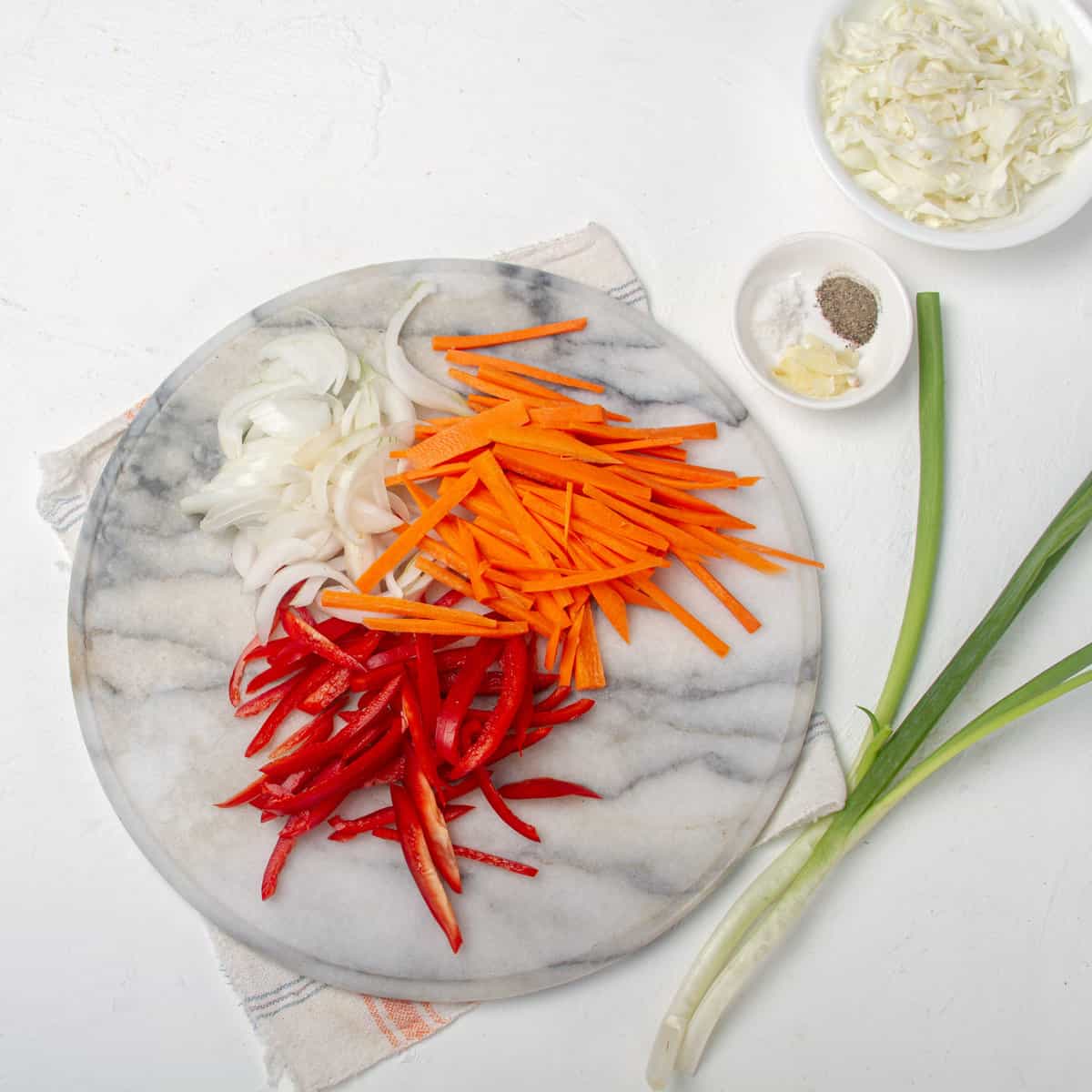
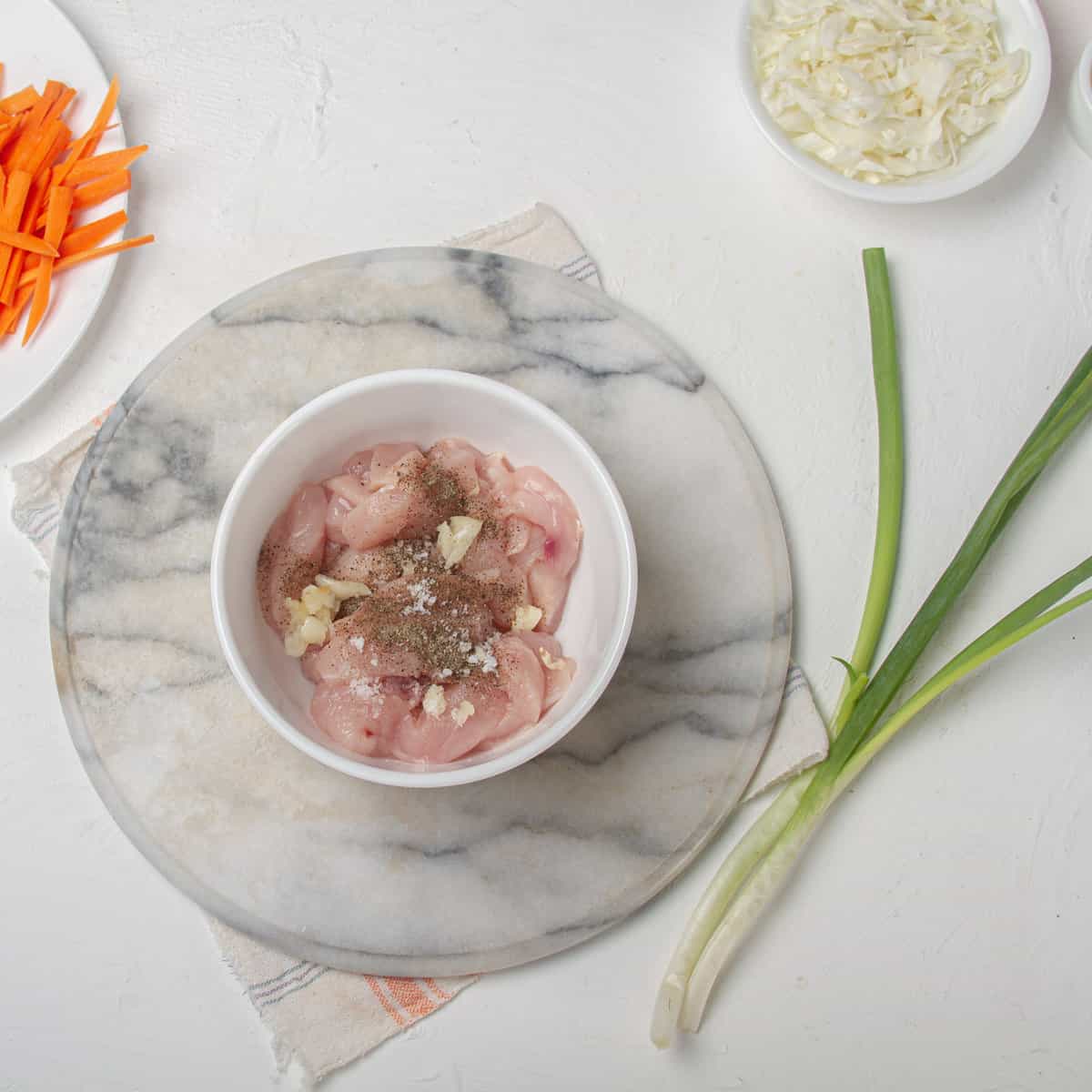
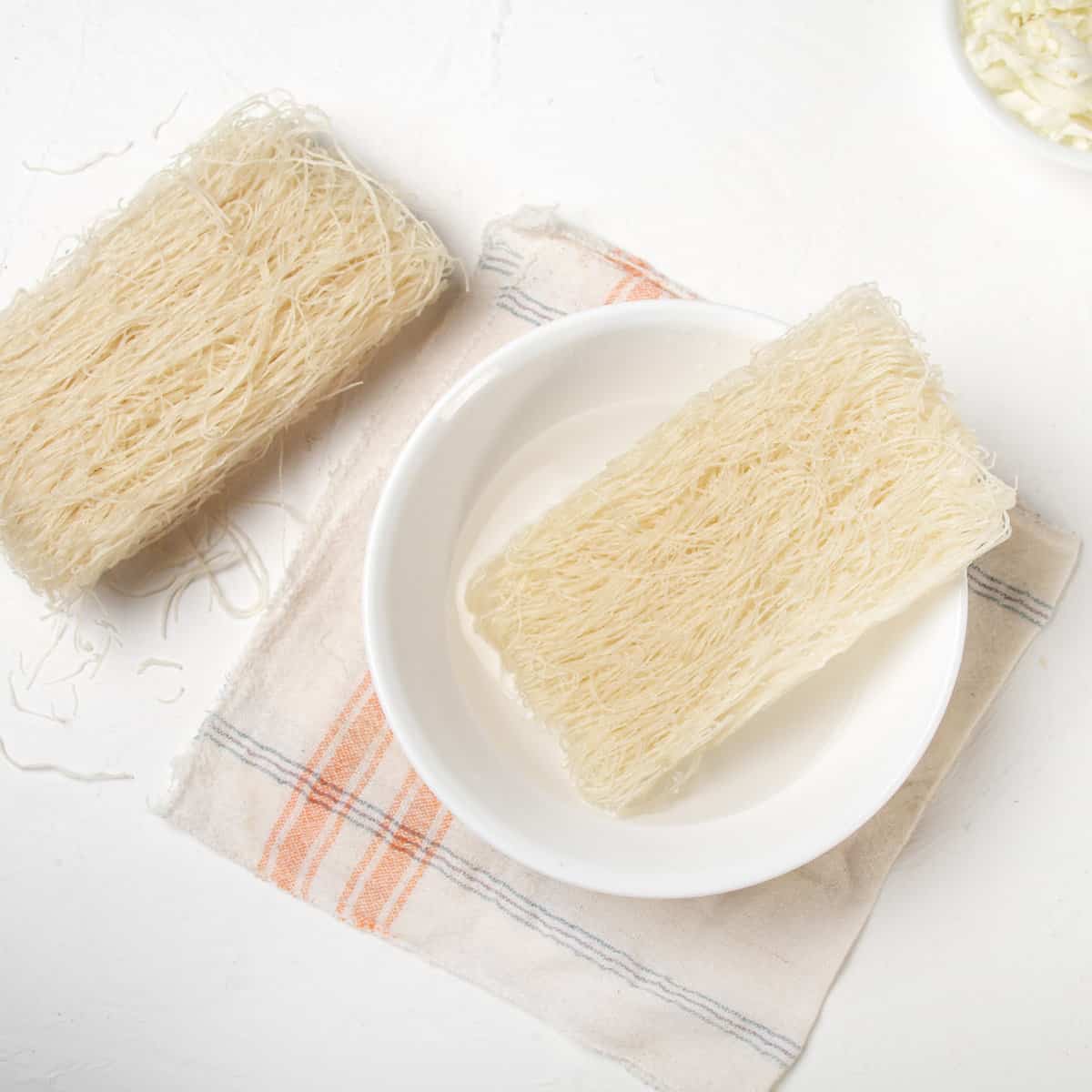
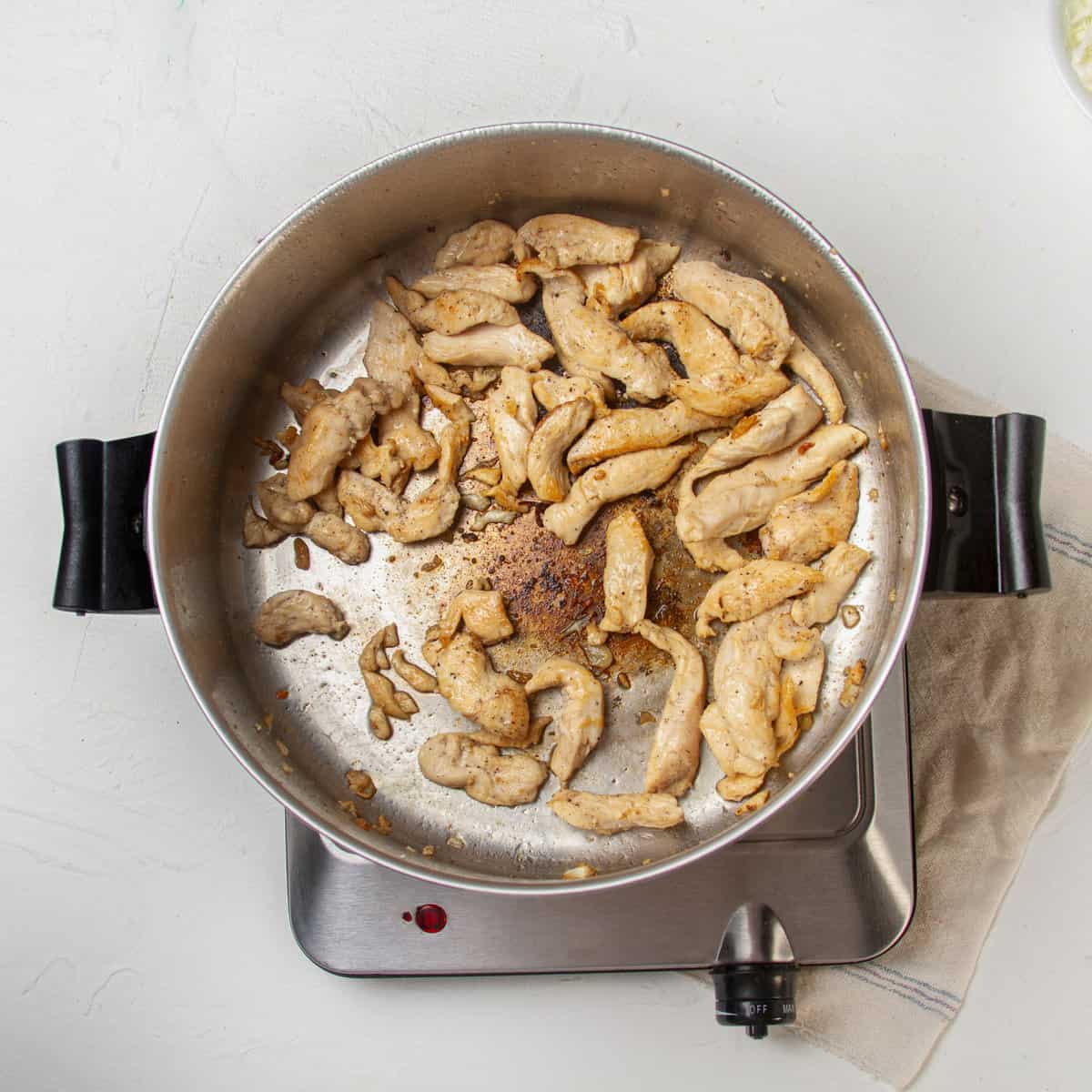
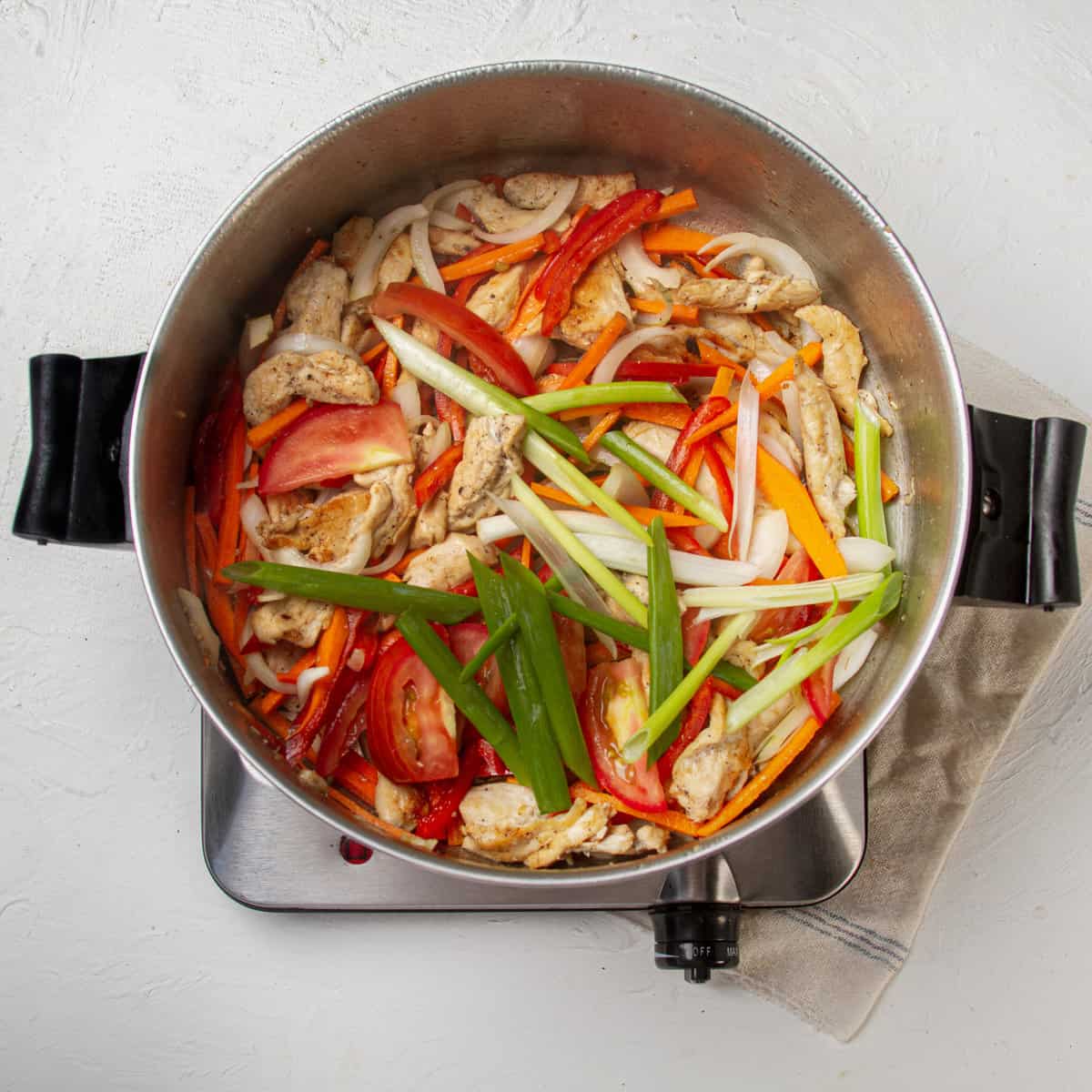
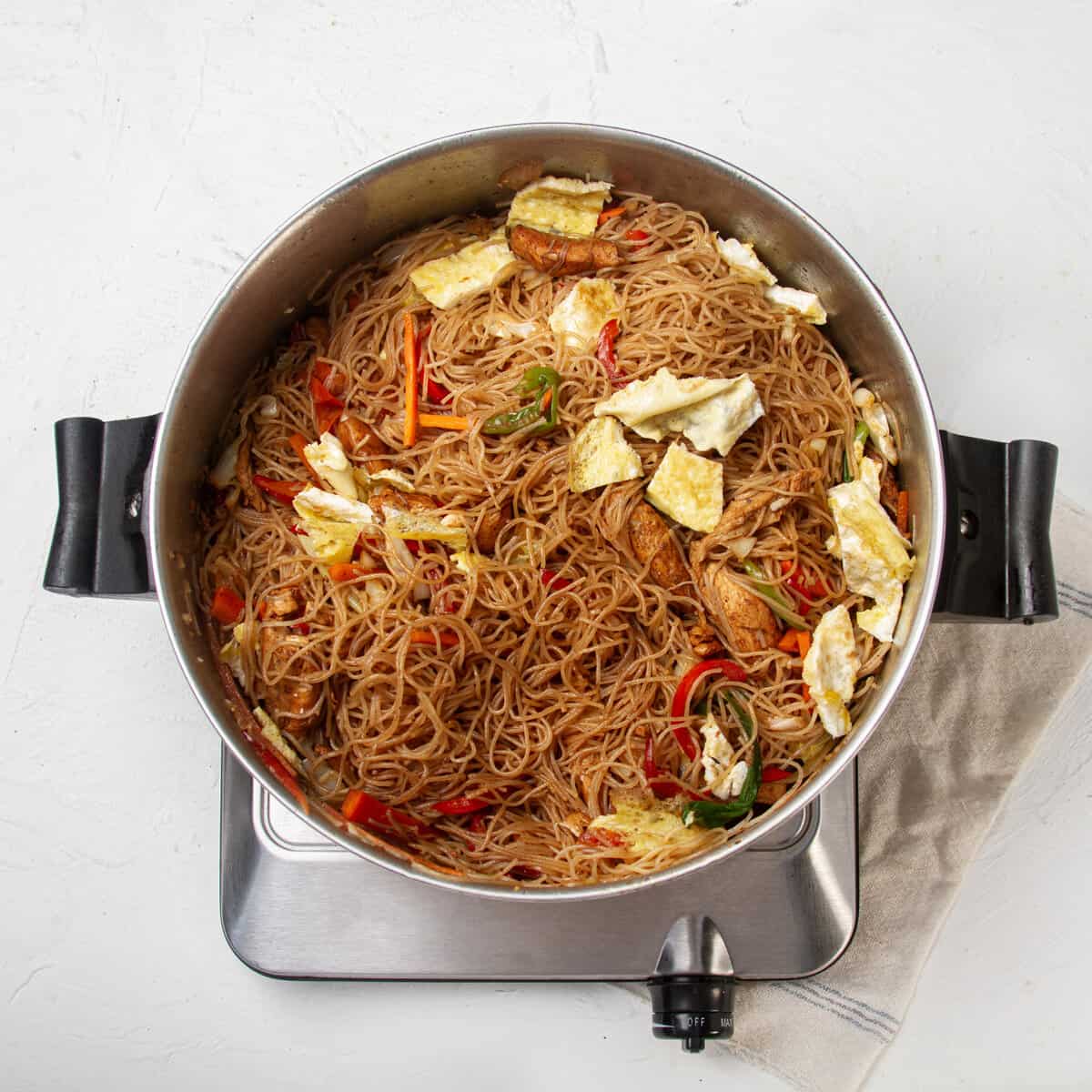
Variations and substitutions
Pad Woon Sen can be adapted to various tastes and preferences. It can be prepared with chicken, tofu, or shrimp, and can be infused with flavors from curry paste, coconut milk, or other regional ingredients.
The vegan adaptation of Pad Woon Sen replaces chicken with tofu. The seafood variation substitutes chicken with succulent shrimp. In the southern rendition of Pad Woon Sen, curry paste, coconut milk, and bitter melon are all essential components. Additionally, this dish offers extensive flexibility when it comes to its vegetable composition. Our version incorporates a medley of carrots, bell peppers, scallions, onions, and even tomatoes, showcasing the dish’s adaptability to diverse ingredients.
Tips and Tricks Section for Making Pad Woon Sen
1. Handling Glass Noodles: Glass noodles can easily become clumped together, so it’s crucial to handle them gently. Before adding them to the dish, soak them in warm water for about 10 minutes until they soften. Drain well and set aside until you’re ready to use them.
2. Don’t Overcook: Glass noodles have a delicate texture and can become mushy if overcooked. When adding them to the pan, make sure your heat is at medium to prevent them from becoming too soft. Stir them into the other ingredients for just a couple of minutes, allowing them to absorb the flavors without losing their pleasant chewiness.
3. Prep All Ingredients First: Since the cooking process for Pad Woon Sen is quite fast-paced, it’s essential to have all your ingredients prepped and ready before you start cooking. This includes slicing the vegetables, preparing the sauce, and having the proteins cooked or marinated. This way, you can quickly toss everything together without overcooking the delicate noodles.
4. Serving Fresh: Glass noodles tend to absorb liquids quickly, so if you plan to have leftovers, it’s a good idea to store the noodles and sauce separately. Mix them together just before reheating or serving to ensure the noodles retain their texture and flavors.
Related Recipes
Pad Woon Sen
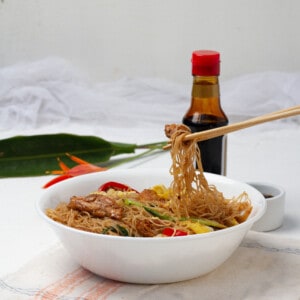
Ingredients
- 100 g glass noodles
- 4 cups of water for soaking the noodles, 1 l.
- 1 tomato, 100 g.
- 1 white onion, 100 g.
- 1 cup finely chopped white cabbage, 150 g.
- 1 red bell pepper, 150 g.
- 1 carrot, 120 g.
- 2 eggs
- 2 stalks of green onion
- 1 teaspoon sesame oil
- 300 g boneless, skinless chicken breast
- 3 tablespoons reduced-sodium soy sauce
- 2 tablespoons oyster sauce
- 1 clove garlic, minced
- 1 teaspoon stevia
- 1 small piece of grated ginger, optional
- Salt and pepper
Instructions
- Start by slicing the vegetables into extremely thin matchsticks. This includes the white onion, green onion, carrot, red bell pepper, and white cabbage. For the tomato, slice it into thin wedges that aren’t excessively thin.
- Cut the chicken breast into bite-sized cubes. Season them with minced garlic, a pinch of salt, and a sprinkle of black pepper. Set the seasoned chicken aside.
- Place the glass noodles in a bowl and cover them with 4 cups of water. You can either soak them all at once or soak them in batches, ensuring you have control over the amount of water they absorb.
- Heat a teaspoon of sesame oil in a large pot or wok over medium-high heat. Add the seasoned chicken cubes and sauté for about 6 minutes, flipping them at the halfway mark. While the chicken cooks, prepare the sauce. In a small bowl, mix the reduced-sodium soy sauce, oyster sauce, stevia, grated ginger (if using), and a quarter cup of water. Stir well and set the sauce aside.
- Once the chicken is cooked through, add all the prepared vegetables – white onion, green onion, carrot, red bell pepper, and white cabbage – to the pot. Stir-fry them until they begin to soften, maintaining their vibrant colors.
- Carefully drain the soaked glass noodles and gently separate them. Add the noodles to the pot along with the sauce. Toss everything together to ensure the flavors are well distributed and the noodles are coated with the sauce.
- In a separate skillet, beat the two eggs to create a thin omelet. Once cooked, slice the omelet into small pieces.
- Just before serving, place the sliced egg omelet on top of the Pad Woon Sen. Serve Immediately: Dish out the Pad Woon Sen into individual serving bowls. Serve immediately to enjoy the flavors and textures at their best.
Notes
Nutrition
Nutrition information is automatically calculated, so should only be used as an approximation.

